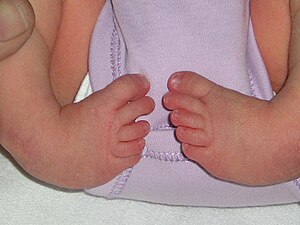Clubfoot
| Club foot | |
|---|---|
 |
|
| Bilateral club foot | |
| Classification and external resources | |
| Specialty | Orthopedics |
| ICD-10 | M21.5, Q66.8 |
| ICD-9-CM | 736.71, 754.5-754.7 |
| OMIM | 119800 |
| DiseasesDB | 29395 |
| MedlinePlus | 001228 |
| eMedicine | radio/177 orthoped/598 |
| MeSH | D003025 |
Club foot or clubfoot, also called Congenital Talipes Equinovarus (CTEV), is a congenital deformity involving one foot or both. The affected foot appears to have been rotated internally at the ankle. Without treatment, people with club feet often appear to walk on their ankles or on the sides of their feet. However, with treatment, the vast majority of patients recover completely during early childhood and are able to walk and participate in athletics just as well as patients born without CTEV.
It is a relatively common birth defect, occurring in about one in every 1,000 live births. Approximately half of people with clubfoot have it affect both feet, which is called bilateral club foot. In most cases it is an isolated disorder of the limbs. It occurs in males twice as frequently as in females.
A condition of the same name appears in some non-human animals, particularly horses, though in that particular case it is more akin to stepping en pointe than sideways.
Hippocrates around 400 B.C. was the first to offer a medical explanation, and to this day there are many hypotheses about how clubfoot develops, involving environmental factors, genetics, or a combination of both. No study has pinpointed the root cause, but most findings agree that "it is likely there is more than one different cause and at least in some cases the phenotype may occur as a result of a threshold effect of different factors acting together."
Some researchers hypothesize, from the early development stages of humans, that clubfoot is formed by a malfunction during gestation. Amniocentesis is believed to increase the rates of this deformity because there is an increase in possible amniotic leakage during the procedure. Underdevelopment of the bones and muscles in the embryonic foot may be another underlying cause. Underdevelopment prevents the fetus's foot from rotating medially, leaving it in the club formation after birth. It was widely believed in the early 1900s that constriction of the foot by the uterus contributed to clubfoot.
Underdevelopment of the bones also affects the muscles and tissues of the foot. Abnormality in the connective tissue causes "the presence of increased fibrous tissue in muscles, fascia, ligaments and tendon sheaths". Affected individuals have smaller than normal legs even after corrected. Further evidence shows that mutations in genes involved in muscle development are risk factors for clubfoot, specifically those encoding the muscle contractile complex (MYH3, TPM2, TNNT3, TNNI2, and MYH8). These can cause congenital contractures, including clubfoot, in distal arthrogryposis (DA) syndromes. Clubfoot can also be present in patients with genetic conditions such as Loeys-Dietz syndrome.
...
Wikipedia
